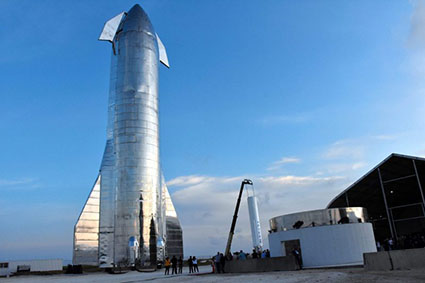by WorldTribune Staff, February 13, 2022
SpaceX’s massive Starship rocket will soon be capable of traveling much greater distances at a significantly lower cost, SpaceX CEO Elon Musk said.
Musk’s ambitious plans for the reusable Starship rocket included a potential mission to Mars. The rocket may also be used to send astronauts to the Moon and deliver hundreds of satellites into orbit at once.

During his Thursday presentation, Musk described civilization as feeling “a little fragile these days” and made his case for reaching Mars to build a self-sustaining city.
China has taken notice of these developments and has substantially increased its investment in reusable space launch technology “by state-owned and ‘private’ companies that are also by Chinese law obliged to contribute to the military space capabilities of the People’s Liberation Army,” Richard Fisher noted in a November analysis for Geostrategy-Direct.com.
The cost for a Starship mission could be less than $10 million a flight within two to three years, Musk said during a presentation Thursday at SpaceX’s southern Texas facility, where the company plans to launch the spacecraft.
Musk said his cost estimate covered all of the company’s expenses to launch. Excluding fixed costs, the number could be even lower, he said. The more Starship launches, the lower the “fully considered cost per flight,” he said.
SpaceX has previously said Starship could be used for a mission to Mars.
Starship is meant to be fully and rapidly reusable and could potentially deliver hundreds of satellites to orbit at once, including those that make up SpaceX’s own growing fleet of broadband satellites, the Wall Street Journal noted in a Feb. 10 report.
Space Exploration Technologies Corp., the formal name for SpaceX, has said it designed the Starship spacecraft to carry more than 100 tons to destinations like the Moon. By comparison, the Saturn V rocket used by NASA for astronaut missions to the Moon was capable of delivering payloads of around one ton to the Moon’s surface, according to an estimate from Dr. Michael Neufeld, senior curator at the Smithsonian National Air and Space Museum.
Last April, NASA awarded SpaceX a $2.9 billion contract to use Starship to deliver astronauts to the lunar surface from Gateway, an agency outpost that would orbit the moon, or from NASA’s Orion spacecraft. Rivals that SpaceX beat out to win the high-profile contract included a team led by Jeff Bezos’ Blue Origin LLC, the Journal’s report noted.
Meanwhile, at China’s 7th Commercial Aerospace Forum in November, six state-owned and “private” Chinese companies made presentations explaining their progress and plans in developing reusable space launch vehicles.
“The state-owned China Aerospace Science and Industry Corporation (CASIC) was featured prominently at the forum. CASIC has built a major factory in the 68.8 square-kilometer Wuhan National Aerospace Industrial Base, a relatively recent local and national government aerospace technology investment project,” Fisher noted.
Space News reported on Nov. 26 that similar investment projects are underway in Guangzhou, Chengdu, Beijing, Changsha, Shenzhen, Xian, and Wenchang, on Hainan Island.
INFORMATION WORLD WAR: . . . . How We Win . . . . Executive Intelligence Brief
